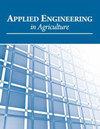Dielectric Constant-Based Grain Mass Estimation Using Radio Frequencies Sensing Technology
IF 0.9
4区 农林科学
Q4 AGRICULTURAL ENGINEERING
引用次数: 0
Abstract
HighlightsRadio frequency sensing technology was used to estimate clean grain mass based on grain moisture content and grain properties.Multiple variable regression analysis was used to develop grain mass estimation model.A grain mass estimation model with high R2 was developed by introducing dielectric properties and phase angle.Parameter of dielectric constant e' indicated the domination of moisture content in grain mass estimation model.Abstract. Grain mass estimation is critical in many precision agriculture applications, especially in yield monitoring during harvest procedures. A new clean grain mass estimation method using Radio Frequency (RF) sensing technology is discussed in this paper. RF sensing technology is sensitive to moisture content and grain properties. In this study, a vector network analyzer (VNA) and a pair of horn antennas were used to collect phase shift and attenuation data from 1 to 18 GHz of grain samples (soybean, canola, and corn) on a static testbed in an anechoic chamber. Using multiple variable linear regression analysis, a comprehensive clean grain mass estimation model was developed based on the dielectric properties of the grain samples derived from the S-Parameters at 13 GHz. Dielectric (e') constant/properties and phase shift were introduced into the regression models and generated a grain mass estimation result with R2 values of 0.976, 0.977, and 0.989 for soybean, canola, and corn samples, respectively. The results indicate that RF sensing technology can reveal how grain attributes interact with electromagnetic fields at a certain frequency and has the potential to provide more accurate sensing methods for estimating grain mass in multiple precision agricultural applications. Keywords: Keywords., Dielectric properties, Grain mass estimation, Microwave frequency, Phase shifts, Radio frequency sensing.基于介电常数的射频传感谷物质量估计
利用射频传感技术,根据籽粒含水率和籽粒性质估算净粒质量。采用多变量回归分析建立了粮食质量估计模型。引入介电特性和相角,建立了具有高R2的颗粒质量估计模型。介电常数e′参数表明了含水率在颗粒质量估计模型中的主导地位。粮食质量估算在许多精准农业应用中是至关重要的,特别是在收获过程中的产量监测中。本文讨论了一种利用射频传感技术估算净粒质量的新方法。射频传感技术对水分含量和谷物特性很敏感。本研究利用矢量网络分析仪(VNA)和一对喇叭天线,在消声室的静态测试台上采集了谷物样品(大豆、油菜和玉米)在1 ~ 18 GHz范围内的相移和衰减数据。利用多变量线性回归分析,建立了基于13 GHz s参数得到的颗粒样品介电特性的综合净粒质量估计模型。在回归模型中引入介电常数/性质和相移,得到大豆、油菜和玉米样品的籽粒质量估计结果,R2值分别为0.976、0.977和0.989。研究结果表明,射频传感技术可以揭示特定频率下粮食属性与电磁场的相互作用,为多种精准农业应用中的粮食质量估算提供更准确的传感方法。关键词:关键词。,介电特性,颗粒质量估计,微波频率,相移,射频传感。
本文章由计算机程序翻译,如有差异,请以英文原文为准。
求助全文
约1分钟内获得全文
求助全文
来源期刊

Applied Engineering in Agriculture
农林科学-农业工程
CiteScore
1.80
自引率
11.10%
发文量
69
审稿时长
6 months
期刊介绍:
This peer-reviewed journal publishes applications of engineering and technology research that address agricultural, food, and biological systems problems. Submissions must include results of practical experiences, tests, or trials presented in a manner and style that will allow easy adaptation by others; results of reviews or studies of installations or applications with substantially new or significant information not readily available in other refereed publications; or a description of successful methods of techniques of education, outreach, or technology transfer.
 求助内容:
求助内容: 应助结果提醒方式:
应助结果提醒方式:


